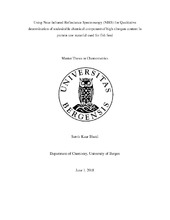Using Near-Infrared Reflectance Spectroscopy (NIRS) for Qualitative determination of undesirable chemical component of high nitrogen content in protein raw material used for fish feed
Master thesis
Permanent lenke
https://hdl.handle.net/1956/18109Utgivelsesdato
2018-06-30Metadata
Vis full innførselSamlinger
- Department of Chemistry [433]
Sammendrag
Food safety and authenticity are important issue. Ingredients presenting high value are the most vulnerable for adulteration as the common practice is to replace original substance partially with cheap and easily available substance for economic gains. Authentication is also of concern to manufacturers who do not wish to be subjected to unfair competition. Fishmeal has been the major source of protein in feeds for farmed fish. Due to increase in the growth of aquaculture production and limited availability of FM, alternative protein sources such as plant proteins (PP) are used. Wheat gluten is a PP source that has given promising results. Wheat gluten is made by washing wheat flour dough with water until all the starch granules and soluble fiber have been removed. It is a high protein raw material with good digestibility and interesting amino acid profile in addition to be used for its binding property. Due to these qualities use of wheat gluten as plant protein source has considerably increased in aquaculture feeds. The aim of this study is to use NIRS and chemometric tools for the early discrimination of adulterated wheat gluten samples from pure wheat gluten samples. A SIMCA model was developed to discriminate between adulterated and unadulterated samples. SIMCA model showed 100 % classification at adulteration level of 3000 ppm. Thus, NIRS together with SIMCA model represent an attractive option for quality screening without sample pretreatments.
